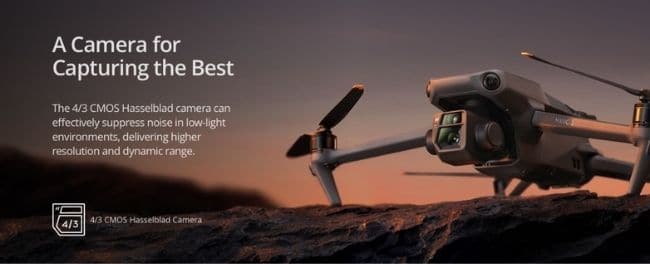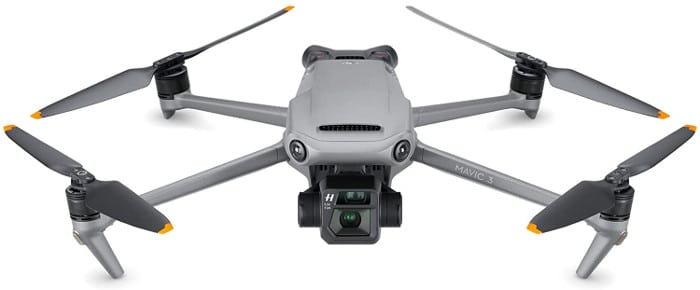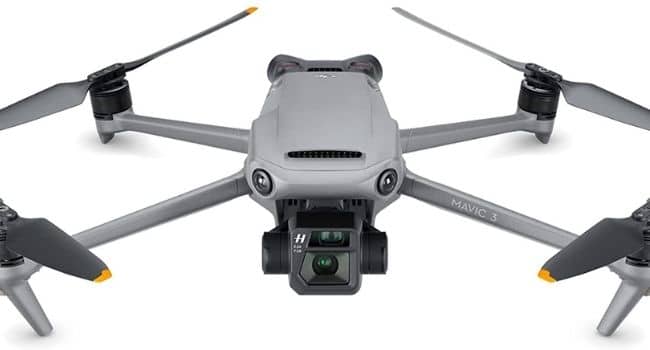The DJI Phantom 4 Pro V2 is one of the DJI’s oldest prosumer drones and the only one from the Phantom range of drones that is still in production. Despite being released a few years, which seems like an eternity in the world of drones, the Phantom 4 Pro V2 is still one of the best drones for photography. However, how does it compare against the new Mavic 3? That is what we shall find out in this Phantom 4 Pro V2 vs Mavic 3 article.
If you want the short answer and don’t want to read the rest of this article, the Mavic 3 is the superior drone, which shouldn’t be a surprise to anyone. It’s a smaller, lighter drone that comes with a dual-camera system, longer flight time, longer transmission range and a better obstacle avoidance system.
The Mavic 3’s superiority does come with a huge price tag and that will be something you will need to take into consideration before you invest in one of these drones.
As many people purchase prosumer drones like the Phantom 4 Pro or the Mavic 3 for commercial purposes or to make money some other way, you will most likely need to register the drone with the government depart that oversees the rules and regulations for aviation flight.
This is most certainly the case in the USA & UK, not only will have to register the drone but you will also be required to sit an exam to obtain a certificate that will grant you permission for commercial flight operations.
In the USA, this is overseen by the FAA and is called the Part 107 remote pilot certificate, it’s a 2-hour multiple-choice exam that will require you to obtain a score of 70% to pass.
In the UK, it is slightly different, you will need to obtain a Flyer & Operator ID, the Flyer ID will require drone pilots to take an online exam. However, you believe that your drone operations will include flying close to people, you will also be required to obtain the General Visual Line of Sight certificate (GVC).
For more information please visit the FAA or CAA websites.
Check out the table below for a quick comparison of the features of each drone.
Phantom 4 Pro V2 vs Mavic 3 – Camera
Image sensor size is a very important factor when it comes to the overall quality of an image, larger sensors usually have higher resolutions, improved dynamic range, and perform better in low light environments.
The Mavic 3 is the first foldable drone that comes with an MFT sensor, this is a huge upgrade to the Mavic 2 Pro and to all other consumer drones.

The camera was engineered jointly with legendary Swiss camera manufacturer, Hasselblad, and comes with their innovative natural colour solution technology for better colour accuracy in every image.
With its large image sensor, the camera can capture 20MP images in 12-bit RAW for true HDR images. Additionally, with features like hyperlight, adjustable aperture and a high ISO range, this camera performs well in any type of lighting conditions.
The camera has a lot of functions that will enable even amateur photographers to capture amazing images. One of these is the Smartphoto mode that will automatically optimise images with HDR without the need for any editing.
As for video recording, the Mavic 3 camera captures video footage in 5.1k at 50fps, DCI4K at 120fps, 4k at 120fps & 1080p at 200fps. The camera has a maximum video bitrate of 200Mbps and can encode videos in both H.264 & H.25, while the Cine version provides the option of encoding videos in Apple ProRes 422 HQ.
Unlike the Phantom 4 Pro, the Mavic 3 provides just two colour options to record in 10-bit D-log and normal. Normal looks fantastic without the need for any post-processing, however, professional videographers will be pleased with the 10-bit D-log option as well.
The secondary camera has a 1/2- CMOS sensor with a 162MM lens, fixed f/4.4 aperture and 15° FOV. It has a hybrid digital/optical zoom lens that allows users to scout and explore by zooming in up to 28×.
The drone has 8GB of internal storage and has a memory card slot that can expand the memory capacity up to 1TB.
While not as good in features as the Mavic 3, the Phantom 4 Pro V2 comes equipped with a very good camera that has a 1-inch CMOS sensor and a mechanical shutter.

A Mechanical shutter helps to capture better images of fast-moving objects by reducing wobble effect.
It also comes with an adjustable aperture and high ISO range for better images with reduced noise in low-light environments.
The camera can capture 20MP images in JPEG & RAW and has multiple photography modes including single, burst at 14 fps and AEB. There is a PIV feature that will allow users to capture images whenever they are recording videos.
Videos are recorded in C4k at 60fps, 4k at 60fps, 2.7k at 60fps & 1080p at 120fps, videos can be recorded at a maximum bitrate of 100Mbps and in both H.264 & H.265 codec.
To capture videos with HDR, users can record in either D-log or D-Cinelike colour profile and there are a few more options that don’t require post-processing.
Unlike the Mavic 3, the Phantom 4 Pro does not come with any internal memory, however, there is a memory card slot that will accept up to 128GB card of class 10 or above.
The Mavic 3 comes with a better camera, its dual-camera system along with Hasselblad engineered camera lens and image sensor provide superior features especially in capturing accurate colour details.
However, the Phantom 4 Pro V2 is still a fantastic alternative for people who want a cheaper alternative for a high-quality drone for photography.
Phantom 4 Pro V2 vs Mavic 3 – Design
For me personally, when it comes to the overall design, I have always been a fan of the compact foldable design of the Mavic range of drones.
The Mavic is no different, despite being a superior drone to the Phantom 4 Pro, it’s a lot smaller and much lighter. In fact, the Mavic 3 is lighter than its predecessor, the Mavic 2 Pro, despite coming with a dual-camera system, which is very impressive engineering work from DJI.
The Mavic 3, like all foldable drones, are great to travel with, as their small size and foldable structure make them easy to pack away without taking up too much space.
The drone has LED flight indicators underneath each rotor arm and an omnidirectional sensing system that consists of a total of 10 sensors that includes sensors on the front, back, top, both sides and bottom.
There is also an auxiliary LED light on the bottom to help the drone land safely if the lighting conditions are not sufficient.
It’s powered by a smart battery that goes in the back and has LEDlights to indicate power level and its smart technology always keeps the battery in optimal condition.
The Phantom 4 Pro V2 is identical to its predecessor and maintains its distinctive architecture like the other phantom drones.
It’s a big drone that weighs just over 1.3kg, not very heavy, but when compared to the Mavic 3, that is a significant weight difference and could be a deciding factor if you wish for a more travel-friendly drone.
Although its weight and size may provide some advantage in less favourable weather conditions.
It has LED lights underneath each rotor that indicates flight status and helps with troubleshooting any issues that may arise with the drone.
The drone is powered by a 4S lithium-polymer battery that goes in the back of the drone and provides it with around 30 minutes of flight time.
There are two different types of controllers for each drone, both use DJI’s advanced OcuSync transmission technology, however, Mavic 3 controller uses the latest 3.0 version which gives it a far longer transmission range of 15km compared to the Phantom 4 Pro’s 10km.
Flight Features & Performance
The Mavic 3 has flight mode, positional, sports and tripod (or cinematic), the positional mode is the default mode, all of the features work in this mode. The tripod or cinematic mode is similar to the default mode except that its speed is reduced to just over 2 mph.
In sports mode, the controls are more sensitive, and the drone can reach its top speed of 42 mph, however, the obstacle avoidance system is disabled in this mode, so you will have to be more aware of your surroundings.
If the drone is unable to connect to a GNSS system and its vision sensor are disabled, it automatically enters altitude hold mode, however, since the Mavic 3 can connect with 3 satellite systems, this rarely happens unless you want to fly in this mode.
The Phantom 4 Pro V2 comes with positional mode and sports mode, it does not have a tripod or cinematic mode. It also enters altitude hold mode if the GPS is disabled and the vision sensors stop working or are disabled.
Both drones come with intelligent flight modes such as active track, point of interest and waypoint. The Mavic comes with some additional intelligent features such as the hyperlapse feature that will allow users to create time-lapse videos from 4 different flight modes, three of these modes are completely autonomous.
Both drones also come with a GPS assisted automatic return to home feature, however, the Mavic 3 is equipped with a more advanced version as the AI processor calculates the most efficient and safe path back to the home point thus conserving battery power and minimising any risk of crashing.
Another intelligent feature of the Mavic 3 is the new creative video capturing mode called Mastershots. This allows users to capture short cinematic videos completely hands-free while drone. performs around 10 different manoeuvres.
Flight performance for both drones is very good, thanks to their advanced flight technology, both drones are easy to operate and perform well even in slightly windy conditions.
The obstacle avoidance system for each drone works as advertised, although the Mavic 3 performs much better in densely populated areas. The Mavic 3 is the closest DJI have gotten to the Skydio 2 drones obstacle avoidance system, hopefully with further updates, it will be as good if not better.
All in all, both drones do not disappoint and perform well in all the major categories.
While most people will purchase these drones for photography/videography, there are other uses for these drones. Thanks to their high-quality camera and autonomous flight modes, both the Mavic 3 & Phantom 4 Pro can be used for things like photogrammetry, inspection, surveillance and even as a tool in emergency response for search & rescue operations.
Which One Is Suitable For You?
While both are fantastic drones and are more than capable of producing professional-grade photos and videos, the Mavic with its amazing MFT Hasselblad camera, ability to record Apple ProRes, host of intelligent features and long flight time is the perfect drone for aerial cinematography.
- Hasselblad camera with MFT sensor
- 20MP images
- Adjustable aperture
- Secondary camera with prime zoom lens
- Records videos in 5.1k at 50fps
- 12.8 stops of dynamic range
- 10-bit D-log colour profile
- Hasselblad natural colour technology
- 46 minutes of flight time
- 15km transmission range
Final Thoughts
While both the Phantom 4 Pro V2 & Mavic 3 are exceptional drones for photography, they are expensive, especially the Mavic 3. If you want a very good alternative, I highly recommend the Mavic Air 2 or the Air 2S, both are very good drones for photography that cost less than $1000, alternatively click on the button below for more options.





The Phantom 4 Pro V2 does have tripod mode. Also when using the Goggles it has cinematic mode via the Goggles.
Being a pro photographer, i can see the advantages of the Magic 3 over the Phantom 4 Pro in a lot of ares, except one MAJOR difference. The Phantom 4 Pro has a 1’ CMOS sensor which is a full frame sensor which is the size used in full frame DSLR’s. The Magic 3 uses a 4/3 sensor (crop sensor; 1/2” sensor) which the same as used in APC-S frame DSKLR cameras. If I am shooting a full frame camera, why in the world would I want to swift from FX to DX and lose all the extra detail I gain by shooting with the full frame?That makes absolutely no sense to me at all. Both of these drone are 20mp image sensors so it wouldn’t be like me going from a 20mp FX two a 24 or 30 or even 36mp DX. It doesn’t matter because crop sensors will never pull the same dea]tail as a full frame sensor regardless of the glass in front of it.
It’s not a full frame sensor is a 1 inch sensor, it maybe the same format but the m43 sensor is a lot better than a 1 inch.
Paul you are aware the Mavic 3 has 2 cameras? tele camera with 1/2″ CMOS sensor and the main Hasselblad with 4/3 CMOS sensor.
The 1/2″ tele camera is really intended to zoom in from a distance to plan your shots with the 4/3″ Hasselblad camera.
you said ” The Magic 3 uses a 4/3 sensor (crop sensor; 1/2” sensor)” You seem to be describing one camera. it has 2. A 4/3 and a 1/2″. the 4/3 is not the 1/2″.
A quick google search explains what I believe you are confused about:
A “1 inch” sensor has about a 3x crop factor. The phrase “One Inch” makes them sound about the same size as a DSLR sensor, since real DSLR sensors are either about an inch wide (crop-frame) or an inch tall (full-frame) — but nothing about a 1″ sensor is anywhere near an inch or the size of a real DSLR sensor!
Either way, as a professional photographer, can you please now explain again how you think a 4/3 sensor is not better than a 1″ sensor?
Why would a “pro photographer” think a 1 inch sensor is a full frame? It has half the area of the four thirds.